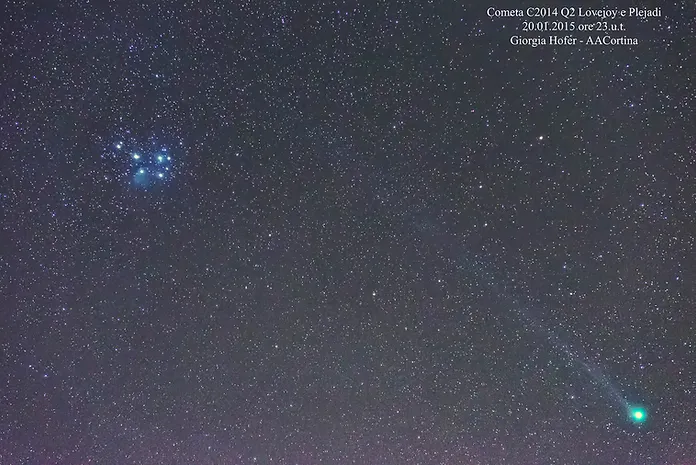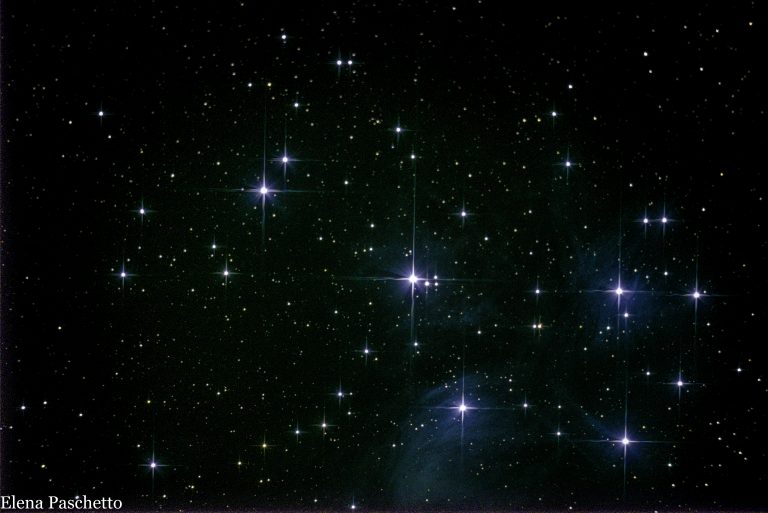Stardust and Eternity – 3.4.4
Globular and Open Clusters
When we observe the night sky, stars appear to be arranged in groups or patterns, such as the Big Dipper or all the other traditional 88 constellations. These associations are often coincidental. Indeed, stars that compose these so-called “asterisms” are not necessarily the product of a physical connection. They may also be the serendipitous result of the particular perspective of their observations projected onto the plane of the sky. Conversely, stars that are physically connected are usually formed in the same region, at about the same time, and from the same interstellar cloud material. These gravitationally bound stars form proper “star clusters”. Two major types of star clusters can be distinguished in our galaxy: globular and open clusters.
“Globular clusters” are groups of densely packed stars, distributed in a roughly spherical volume, of approximately tens of light years across. They contain from a few thousands to several million stars. Unlike most stars, they are typically found in a spherical region surrounding the galactic centre – galactic halo – orbiting above and below the flat galactic disc. Located far from the galactic plane, and therefore situated in regions mostly devoid of interstellar dust and gas, they can be observed at very long distances. In the Norther hemisphere, for instance, the globular cluster M13 – belonging to the constellation of Hercules, which was discovered by Edmond Halley in 1714 and catalogued by Charles Messier – can be easily observed with a low-power telescope, despite being more than 20,000 light years away from Earth! Thanks to the analysis of their electromagnetic spectrum, we now know that the stars that form globular clusters have much smaller amounts of heavy elements than the stars that lie in the plane of the galaxy – such as the Sun. This implies that they are among the oldest objects in our 13.7 billion years old universe, with ages ranging from about 11 to 13 billion years. Indeed, the more massive blue and white stars in globular clusters – whose lifetime is much shorter – have long since disappeared, leaving only old red and yellow stars of lower mass. Globular clusters thus represent a precious astronomical tool to investigate the early history of the Milky Way.
Unlike globular clusters, “open clusters” are associations of stars that are much younger and closer to the galactic plane. Their shape is irregular, as they are composed of combinations of a few tens or thousands of stars and surrounded by traces of the interstellar clouds of gas and dust – or “nebulae” – from which they were originally created. Although they originated around the same time, the stars that make up open clusters are doomed not to remain gravitationally bound over time: their fate is to scatter and disrupt after surviving only a few hundred million years. Similar in age and chemical composition, members of the open clusters are important tools to study the evolution of stars of different masses. Their appearance is usually characterised by a few hot blue or white O-type and B-type stars: they are so massive that they live only a few tens of millions of years. The Pleiades constellation (M45 in the Messier catalogue), located in the constellation of Taurus about 440 light years away and less than 100 million years old, is probably the most famous open cluster visible with the naked eye.


Further Resources
Links below will redirect you to external websites. In accordance with the European data protection declarations, we would like to point out that by clicking on these links you may send data to external providers. We cannot prevent that.
Images
![]() Globular Cluster NGC 1866: Different generations (ESA/Hubble & NASA)
Globular Cluster NGC 1866: Different generations (ESA/Hubble & NASA)
![]() Globular Cluster NGC 1466 (ESA/Hubble & NASA)
Globular Cluster NGC 1466 (ESA/Hubble & NASA)
![]() M54, first globular cluster outside the Milky Way (ESA/Hubble & NASA)
M54, first globular cluster outside the Milky Way (ESA/Hubble & NASA)
![]() Open star cluster NGC 6611 in the Eagle Nebula (ESA/Hubble & NASA)
Open star cluster NGC 6611 in the Eagle Nebula (ESA/Hubble & NASA)
![]() The Pleiades Open star cluster (ESA/Hubble & NASA)
The Pleiades Open star cluster (ESA/Hubble & NASA)
Videos
![]() Star Clusters (Crash Course Astronomy)
Star Clusters (Crash Course Astronomy)
![]() What are Globular Clusters? Relics of the Early Universe
What are Globular Clusters? Relics of the Early Universe
![]() Star Clusters – Open and Globular Clusters
Star Clusters – Open and Globular Clusters
 Gli ammassi stellari (Antonio Loiacono)
Gli ammassi stellari (Antonio Loiacono)
 Cosa sono gli ammassi stellari? (Link4universe)
Cosa sono gli ammassi stellari? (Link4universe)
 Ammassi globulari con materia oscura? (MEDIAINAF TV)
Ammassi globulari con materia oscura? (MEDIAINAF TV)
Online Resources
![]() Measuring the Age of a Star Cluster
Measuring the Age of a Star Cluster
![]() Five Star clusters to see with naked eye
Five Star clusters to see with naked eye
 Ammassi stellari, compagnie di astri nascenti (Media INAF)
Ammassi stellari, compagnie di astri nascenti (Media INAF)
 Ammassi stellari (IRIDEOS)
Ammassi stellari (IRIDEOS)
 Ammasso stellare (Chimica online)
Ammasso stellare (Chimica online)
Further Readings
![]() The Complex Lives of Star Clusters (David Stevenson)
The Complex Lives of Star Clusters (David Stevenson)
![]() Concise Catalog of Deep-Sky Objects (Warren H. Finlay)
Concise Catalog of Deep-Sky Objects (Warren H. Finlay)
![]() Star Clusters A Pocket Field Guide (Charles A. Cardona III, Jan Wisniewski)
Star Clusters A Pocket Field Guide (Charles A. Cardona III, Jan Wisniewski)
![]() Observer’s Guide to Star Clusters (Mike Inglis)
Observer’s Guide to Star Clusters (Mike Inglis)
![]() Star Clusters and How to Observe Them (Mark Allison)
Star Clusters and How to Observe Them (Mark Allison)
 Gli Ammassi Stellari (Valentina Alberti)
Gli Ammassi Stellari (Valentina Alberti)
 Asterosismologia per studiare gli ammassi stellari (Ufficio stampa UniBo)
Asterosismologia per studiare gli ammassi stellari (Ufficio stampa UniBo)
Teaching Material
![]() Learn mathematics with Star clusters
Learn mathematics with Star clusters
 AMMASSI STELLARI (INAF – Osservatorio Astronomico di Trieste)
AMMASSI STELLARI (INAF – Osservatorio Astronomico di Trieste)
For Kids
 Parliamo di Ammassi Stellari (video)
Parliamo di Ammassi Stellari (video)
